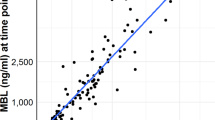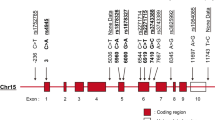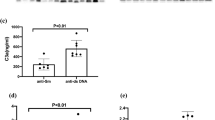Abstract
Altered function of selectin glycoprotein adhesion molecules may modulate severity and organ-specific manifestations of autoimmune and inflammatory disease via changes in leukocyte trafficking. Serum concentrations of selectin molecules have been suggested as useful biomarkers in systemic lupus erythematosus (SLE). We identified increased levels of soluble L-selectin (sL-selectin), but not soluble E-selectin (sE-selectin) in 278 European-Caucasian lupus patients compared to 230 healthy siblings (P=0.002). sL-selectin levels were markedly elevated in patients with IgG antiphospholipid autoantibodies (P=0.002), suggesting that perhaps sL-selectin defines a subgroup of lupus with vasculopathy. sL-selectin level was also influenced by two L-selectin polymorphisms: 665C>T, F206L in the epidermal growth factor-like domain (P=0.015) and rs12938 in the 3′-untranslated region (P=0.06). Having shown increased sL-selectin levels in lupus patients, we used genetics to investigate whether this was a secondary phenomena or the result of an underlying genetic mechanism. The inheritance of nine single-nucleotide polymorphisms (SNP) spanning the selectin locus was tested in 523 UK simplex SLE families. No association with SLE, or related phenotypes, was evident with any single SNP, or haplotype in family-based tests of association. Selectin polymorphisms are, therefore, unlikely to be independent factors in SLE susceptibility.
This is a preview of subscription content, access via your institution
Access options
Subscribe to this journal
Receive 6 digital issues and online access to articles
$119.00 per year
only $19.83 per issue
Buy this article
- Purchase on Springer Link
- Instant access to full article PDF
Prices may be subject to local taxes which are calculated during checkout


Similar content being viewed by others
References
Kotzin BL . Systemic lupus erythematosus. Cell 1996; 85: 303–306.
Bevilacqua MP, Nelson RM . Selectins. J Clin Invest 1993; 91: 379–387.
Gallatin WM, Weissman IL, Butcher EC . A cell-surface molecule involved in organ-specific homing of lymphocytes. Nature 1983; 304: 30–34.
Corkill MM, Kirkham BW, Haskard DO, Barbatis C, Gibson T, Panayi GS . Gold treatment of rheumatoid arthritis decreases synovial expression of the endothelial leukocyte adhesion receptor ELAM-1. J Rheumatol 1991; 18: 1453–1460.
van der Wal AC, Das PK, Tigges AJ, Becker AE . Adhesion molecules on the endothelium and mononuclear cells in human atherosclerotic lesions. Am J Pathol 1992; 141: 1427–1433.
Arbones ML, Ord DC, Ley K et al. Lymphocyte homing and leukocyte rolling and migration are impaired in L-selectin-deficient mice. Immunity 1994; 1: 247–260.
Labow MA, Norton CR, Rumberger JM et al. Characterization of E-selectin-deficient mice: demonstration of overlapping function of the endothelial selectins. Immunity 1994; 1: 709–720.
Kunkel EJ, Ley K . Distinct phenotype of E-selectin-deficient mice. E-selectin is required for slow leukocyte rolling in vivo. Circ Res 1996; 79: 1196–1204.
Belmont HM, Buyon J, Giorno R, Abramson S . Up-regulation of endothelial cell adhesion molecules characterizes disease activity in systemic lupus erythematosus. The Shwartzman phenomenon revisited. Arthritis Rheum 1994; 37: 376–383.
Egerer K, Feist E, Rohr U, Pruss A, Burmester GR, Dorner T . Increased serum soluble CD14, ICAM-1 and E-selectin correlate with disease activity and prognosis in systemic lupus erythematosus. Lupus 2000; 9: 614–621.
Font J, Pizcueta P, Ramos-Casals M et al. Increased serum levels of soluble L-selectin (CD62L) in patients with active systemic lupus erythematosus (SLE). Clin Exp Immunol 2000; 119: 169–174.
Bloom BJ, Miller LC, Blier PR . Soluble adhesion molecules in pediatric rheumatic diseases. J Rheumatol 2002; 29: 832–836.
Kishimoto TK, Jutila MA, Berg EL, Butcher EC . Neutrophil Mac-1 and MEL-14 adhesion proteins inversely regulated by chemotactic factors. Science 1989; 245: 1238–1241.
Peschon JJ, Slack JL, Reddy P et al. An essential role for ectodomain shedding in mammalian development. Science 1998; 282: 1279–1280.
Schleiffenbaum B, Spertini O, Tedder TF . Soluble L-selectin is present in human plasma at high levels and retains functional activity. J Cell Biol 1992; 119: 229–238.
Tu L, Poe JC, Kadono T et al. A functional role for circulating mouse L-selectin in regulating leukocyte/endothelial cell interactions in vivo. J Immunol 2002; 169: 2034–2043.
Lobb RR, Chi-Rosso G, Leone DR et al. Expression and functional characterization of a soluble form of endothelial-leukocyte adhesion molecule 1. J Immunol 1991; 147: 124–129.
Takahashi S, Araki K, Araki M et al. Suppression of experimental lupus nephritis by aberrant expression of the soluble E-selectin gene. Pathol Int 2002; 52: 175–180.
Moser KL, Neas BR, Salmon JE et al. Genome scan of human systemic lupus erythematosus: evidence for linkage on chromosome 1q in African-American pedigrees. Proc Natl Acad Sci USA 1998; 95: 14869–14874.
Gaffney PM, Kearns GM, Shark KB et al. A genome-wide search for susceptibility genes in human systemic lupus erythematosus sib-pair families. Proc Natl Acad Sci USA 1998; 95: 14875–14879.
Gaffney PM, Ortmann WA, Selby SA et al. Genome screening in human systemic lupus erythematosus: results from a second Minnesota cohort and combined analyses of 187 sib-pair families. Am J Hum Genet 2000; 66: 547–556.
Shai R, Quismorio Jr FP, Li L et al. Genome-wide screen for systemic lupus erythematosus susceptibility genes in multiplex families. Hum Mol Genet 1999; 8: 639–644.
Lindqvist AK, Steinsson K, Johanneson B et al. A susceptibility locus for human systemic lupus erythematosus (hSLE1) on chromosome 2q. J Autoimmun 2000; 14: 169–178.
Kingsmore SF, Watson ML, Howard TA, Seldin MF . A 6000 kb segment of chromosome 1 is conserved in human and mouse. EMBO J 1989; 8: 4073–4080.
Vyse TJ, Kotzin BL . Genetic susceptibility to systemic lupus erythematosus. Annu Rev Immunol 1998; 16: 261–292.
El Magadmi M, Alansari A, Teh LS et al. Association of the A561C E-selectin polymorphism with systemic lupus erythematosus in 2 independent populations. J Rheumatol 2001; 28: 2650–2652.
Wenzel K, Felix S, Kleber FX et al. E-selectin polymorphism and atherosclerosis: an association study. Hum Mol Genet 1994; 3: 1935–1937.
Wenzel K, Ernst M, Rohde K, Baumann G, Speer A . DNA polymorphisms in adhesion molecule genes—a new risk factor for early atherosclerosis. Hum Genet 1996; 97: 15–20.
Ye SQ, Usher D, Virgil D, Zhang LQ, Yochim SE, Gupta R . A PstI polymorphism detects the mutation of serine128 to arginine in CD62E gene—a risk factor for coronary artery disease. J Biomed Sci 1999; 6: 18–21.
Urowitz M, Gladman D, Bruce I . Atherosclerosis and systemic lupus erythematosus. Curr Rheumatol Rep 2000; 2: 19–23.
Takei T, Iida A, Nitta K et al. Association between single-nucleotide polymorphisms in selectin genes and immunoglobulin A nephropathy. Am J Hum Genet 2002; 70: 781–786.
Russell AI, Cunninghame Graham DS, Shepherd C et al. Polymorphism at the C-reactive protein locus influences gene expression and predisposes to systemic lupus erythematosus. Hum Mol Genet 2004; 13: 137–147 (Epub 25 Nov 2003).
Tan EM, Cohen AS, Fries JF et al. The 1982 revised criteria for the classification of systemic lupus erythematosus. Arthritis Rheum 1982; 25: 1271–1277.
Zheng F, Chevalier JA, Zhang LQ, Virgil D, Ye SQ, Kwiterovich PO . An HphI polymorphism in the E-selectin gene is associated with premature coronary artery disease. Clin Genet 2001; 59: 58–64.
Clayton D . A generalization of the transmission/disequilibrium test for uncertain-haplotype transmission. Am J Hum Genet 1999; 65: 1170–1177.
Lewontin RC . The interaction of selection and linkage. I. General considerations; heterotic models. Genetics 1964; 49: 49–67.
Risch N, Merikangas K . The future of genetic studies of complex human diseases. Science 1996; 273: 1516–1517.
Cervino AC, Hill AV . Comparison of tests for association and linkage in incomplete families. Am J Hum Genet 2000; 67: 120–132.
Martin ER, Monks SA, Warren LL, Kaplan NL . A test for linkage and association in general pedigrees: the pedigree disequilibrium test. Am J Hum Genet 2000; 67: 146–154.
Sfikakis PP, Charalambopoulos D, Vaiopoulos G, Mavrikakis M . Circulating P- and L-selectin and T-lymphocyte activation and patients with autoimmune rheumatic diseases 1. Clin Rheumatol 1999; 18: 28–32.
Revelle BM, Scott D, Beck PJ . Single amino acid residues in the E- and P-selectin epidermal growth factor domains can determine carbohydrate binding specificity. J Biol Chem 1996; 271: 16160–16170.
Rao RM, Clarke JL, Ortlepp S, Robinson MK, Landis RC, Haskard DO . The S128R polymorphism of E-selectin mediates neuraminidase-resistant tethering of myeloid cells under shear flow. Eur J Immunol 2002; 32: 251–260.
Conne B, Stutz A, Vassalli JD . The 3′ untranslated region of messenger RNA: A molecular ‘hotspot’ for pathology? Nat Med 2000; 6: 637–641.
Nyberg F, Stephansson E . Elevated soluble E-selectin in cutaneous lupus erythematosus. Adv Exp Med Biol 1999; 455: 153–159.
Janssen BA, Luqmani RA, Gordon C et al. Correlation of blood levels of soluble vascular cell adhesion molecule-1 with disease activity in systemic lupus erythematosus and vasculitis. Br J Rheumatol 1994; 33: 1112–1116.
Bannan S, Mansfield MW, Grant PJ . Soluble vascular cell adhesion molecule-1 and E-selectin levels in relation to vascular risk factors and to E-selectin genotype in the first degree relatives of NIDDM patients and in NIDDM patients. Diabetologia 1998; 41: 460–466.
Donnelly SC, Haslett C, Dransfield I et al. Role of selectins in development of adult respiratory distress syndrome. Lancet 1994; 344: 215–219.
Siemiatkowski A, Rogowski F, Wereszczynska-Siemiatkowska U, Malinowska L, Borkowski J . Soluble selectin profiles associated with severe trauma. Arch Immunol Ther Exp (Warsz) 2001; 49: 317–324.
Cella G, Bellotto F, Tona F et al. Plasma markers of endothelial dysfunction in pulmonary hypertension. Chest 2001; 120: 1226–1230.
Haught WH, Mansour M, Rothlein R et al. Alterations in circulating intercellular adhesion molecule-1 and L-selectin: further evidence for chronic inflammation in ischemic heart disease. Am Heart J 1996; 132: 1–8.
Author information
Authors and Affiliations
Corresponding author
Rights and permissions
About this article
Cite this article
Russell, A., Graham, D., Chadha, S. et al. No association between E- and L-selectin genes and SLE: soluble L-selectin levels do correlate with genotype and a subset in SLE. Genes Immun 6, 422–429 (2005). https://doi.org/10.1038/sj.gene.6364222
Received:
Accepted:
Published:
Issue Date:
DOI: https://doi.org/10.1038/sj.gene.6364222



